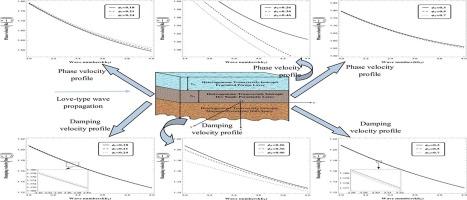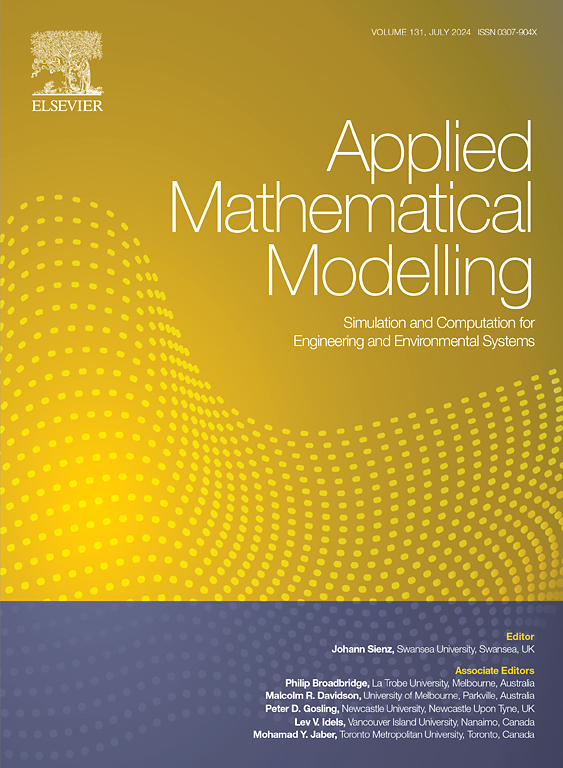复合横向各向同性多孔结构中爱型波传播的动力学特性
IF 4.4
2区 工程技术
Q1 ENGINEERING, MULTIDISCIPLINARY
引用次数: 0
摘要
本研究旨在分析洛夫型波在横向各向同性复合多孔结构中的传播行为。该结构包括位于非均质磁孔弹性层和异质断裂多孔半空间之间的非均质砂质多孔层。对各自介质场方程的分析求解涉及应用可变分离法和 Wentzel-Kramers-Brillouin (WKB) 渐近法将偏微分方程转换为常微分方程。通过仔细施加边界条件和随后消除任意常数,我们推导出了管理洛夫型波传播的复杂频散关系。这个频散方程既能产生与实数表达式相对应的相位速度曲线,也能产生由虚数表达式导出的阻尼速度曲线。为了体现我们的研究结果,我们使用 MATHEMATICA 软件进行了大量计算和图形模拟,以说明各种材料参数(如异质性、孔隙率、裂缝体积分数、砂度、磁弹性耦合、波穿过磁场的角度和层厚度)对爱氏波色散特性的影响。此外,我们还进行了针对具体情况的分析,揭示了色散方程简化为标准洛夫波方程的情况,从而验证了我们的数学框架。我们的研究结果强调了上述材料参数对爱波相位和阻尼速度的重要影响。这项针对不同多孔介质的跨学科研究为未来研究开辟了新途径,对工程学、地球物理学、环境科学等多个学科都有重要影响。本文章由计算机程序翻译,如有差异,请以英文原文为准。

Dynamics of Love-type wave propagation in composite transversely isotropic porous structures
The present study aims to analyze the propagation behavior of Love-type wave in a composite transversely isotropic porous structure. The structure comprises an inhomogeneous sandy porous layer lying between a non-homogeneous magneto-poroelastic layer and a heterogeneous fractured porous half-space. Analytic solutions of the field equations of the respective media involve the application of the variable separable method and Wentzel-Kramers-Brillouin (WKB) asymptotic approach for the conversion of partial differential equations into ordinary differential equations. Through careful imposition of boundary conditions and subsequent elimination of arbitrary constants, we derive a complex dispersion relation governing the propagation of Love-type waves. This dispersion equation yields both the phase velocity curve, corresponding to the real expression, and the damping velocity curve, derived from the imaginary expression. To represent our findings, we conduct extensive calculations and graphical simulations illustrating the influence of various material parameters such as heterogeneity, porosity, volume fraction of fractures, sandiness, magnet-oelastic coupling, angle at which wave crosses the magnetic field, and layer thickness on the dispersive nature of Love-type waves using MATHEMATICA software. Furthermore, we conduct case-specific analyses, revealing instances where the dispersion equation simplifies to the standard Love wave equation, thereby validating our mathematical framework. Our findings underscore the significant influence of the aforementioned material parameters on the phase and damping velocities of Love-type wave. This interdisciplinary investigation into different porous media opens new avenues for future research and has significant implications in various disciplines, ranging from engineering and geophysics to environmental science and beyond.
求助全文
通过发布文献求助,成功后即可免费获取论文全文。
去求助
来源期刊

Applied Mathematical Modelling
数学-工程:综合
CiteScore
9.80
自引率
8.00%
发文量
508
审稿时长
43 days
期刊介绍:
Applied Mathematical Modelling focuses on research related to the mathematical modelling of engineering and environmental processes, manufacturing, and industrial systems. A significant emerging area of research activity involves multiphysics processes, and contributions in this area are particularly encouraged.
This influential publication covers a wide spectrum of subjects including heat transfer, fluid mechanics, CFD, and transport phenomena; solid mechanics and mechanics of metals; electromagnets and MHD; reliability modelling and system optimization; finite volume, finite element, and boundary element procedures; modelling of inventory, industrial, manufacturing and logistics systems for viable decision making; civil engineering systems and structures; mineral and energy resources; relevant software engineering issues associated with CAD and CAE; and materials and metallurgical engineering.
Applied Mathematical Modelling is primarily interested in papers developing increased insights into real-world problems through novel mathematical modelling, novel applications or a combination of these. Papers employing existing numerical techniques must demonstrate sufficient novelty in the solution of practical problems. Papers on fuzzy logic in decision-making or purely financial mathematics are normally not considered. Research on fractional differential equations, bifurcation, and numerical methods needs to include practical examples. Population dynamics must solve realistic scenarios. Papers in the area of logistics and business modelling should demonstrate meaningful managerial insight. Submissions with no real-world application will not be considered.
 求助内容:
求助内容: 应助结果提醒方式:
应助结果提醒方式:


